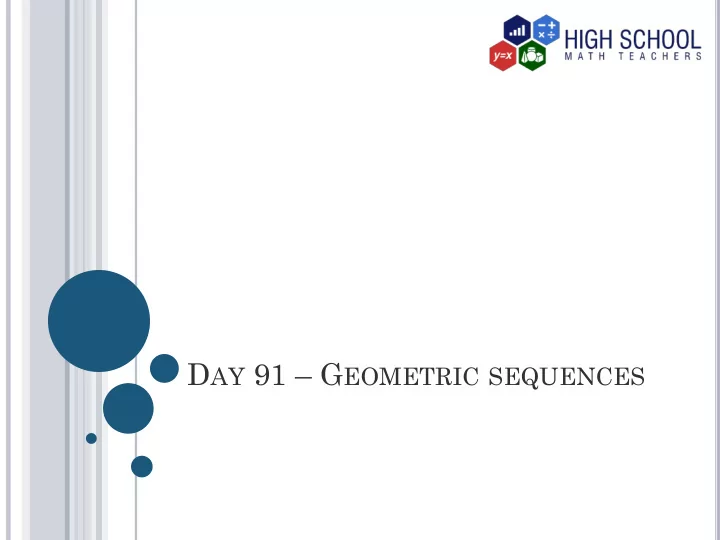

D AY 91 – G EOMETRIC SEQUENCES
W ORD P ROBLEM 1 The Fable of the Chess Board and the Grains of Wheat There is a well-known fable about a man from India who invented the game of chess, as a gift for his king. The king was so pleased with the game that he offered to grant the man any request within reason. The man asked for one grain of wheat to be placed on the first square of the chessboard, two grains to be placed on the second square, four on the third, eight on the fourth, etc., doubling the number of grains of wheat each time, until all 64 squares on the board had been used. The king, thinking this to be a small request, agreed. A chess board has 64 squares. How many grains of wheat did the king have to place on the 64 th square of the chess board?
T ASKS a. Complete the chart: b. Write a function to illustrate the situation.
c. Plot the data and graph the function for squares 1 through 10.
A NSWER K EY Complete the chart a. FYI: In total, the king placed 18,446,744,073,709,551,615 grains of wheat on the board. This is more wheat than exists in the entire world. China is the largest producer of wheat, producing approximately 3.8 billion bushels per year. It would take China well over 6000 years to fill the 64 squares on the chess board. b. Function: from pattern: y x x y = 1(1 + 1.00) 2
c. Plot the data and graph the function for squares 1 through 10.
W ORD P ROBLEM 2 Bacteria Growth A scientist has discovered a new strain of bacteria. The bacteria culture initially contained 1000 bacteria and the bacteria are doubling every half hour.
Y OUR TASK a. Complete the chart for the first five hours: b. Write a function to illustrate the situation.
c. Plot the data and graph the function for the first 4 time intervals.
d. From your graph, determine how many bacteria are present after 45 minutes.
A NSWER K EY a. Complete the chart: b. Function: y = 1000 (1+1.00) x From pattern: y = 1000 * 2 x
c. Graph: horizontal axis = 30 min. time intervals vertical axis = number of bacteria
d. Find the number of bacteria present after 45 minutes. From looking at the data table: 45 minutes is half way between 30 minutes and one hour. If this process were "linear" we could make an estimate of the bacteria to be half way between 2000 and 4000 which would be 3000 bacteria. However, exponential growth is not linear. If you examine the graph, the number of bacteria at 45 minutes equals 2828.4271 bacteria.
W ORD P ROBLEM 3 Growth In 1985, there were 285 cell phone subscribers in the small town of Centerville. The number of subscriber increased by 75% per year after 1985. How many cell phone subscribers were in Centerville in 1994? (Don’t consider a fractional part of a person)
a. Complete the chart. b. Write a function to illustrate the situation.
c. Plot the data and graph the function.
A NSWER K EY a. Complete the chart. b. Write a function to illustrate the situation. ( Function: x 1 ) a = the initial amount before the growth begins y a r r = growth rate x = the number of intervals 285 x ( 1 0 . 75 ) as x ranges from 1 to 9 for this problem y
c. Plot the data and graph the function.
W ORD P ROBLEM 4 Decay: Each year the local country club sponsors a tennis tournament. Play starts with 128 participants. During each round, half of the players are eliminated. How many players remain after 5 rounds?
a. Complete the chart b. Write a function to illustrate the situation.
c. Plot the data and graph the function.
A NSWER K EY a. Complete the chart b. Write a function to illustrate the situation. ( x Function: 1 ) a = the initial amount before the decay y a r begins r = decay rate x = the number of intervals 128 x ( 1 0 . 50 ) as x ranges form 1 to 5 for this problem y
c. Plot the data and graph the function.
Recommend
More recommend